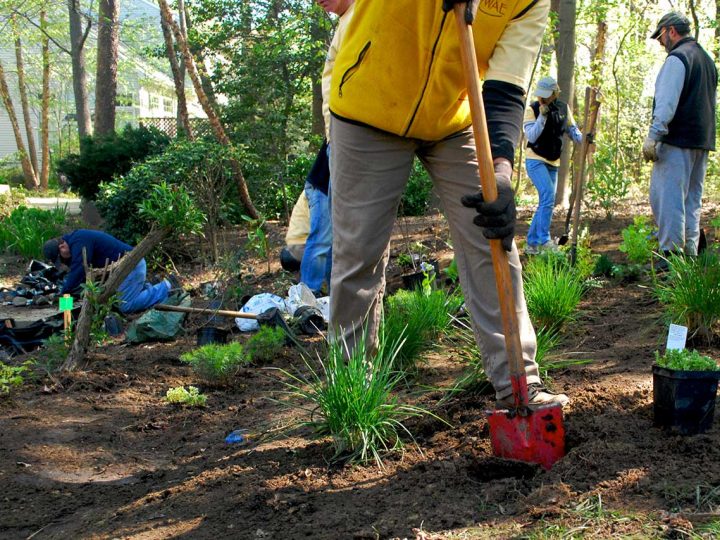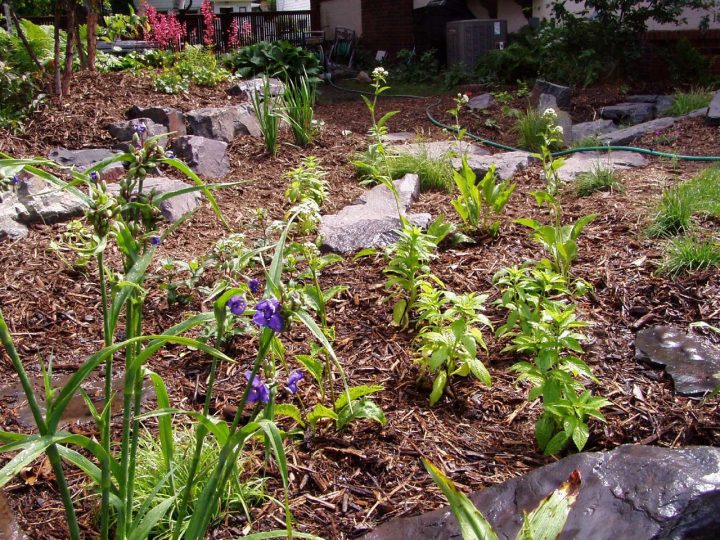
8 Mile Rain Garden
Easy-to-build side lot rain garden designed with plants commonly available at local shops and national chains.
Cost
People
Upkeep
Experience
Stormwater
Sun/Shade
The 8 Mile Rain Garden design is a six-inch bowl that captures stormwater and slowly releases it into the soil, keeping it from entering Detroit’s overtaxed sewerage system. The 8 Mile Rain Garden is ideal for a homeowner looking to create a productive landscape by using their disconnected downspout to water this small garden.
This design includes a vibrant mixture of native and non-native plants, and provides multiple planting options that have been selected to brighten property and provide habitat.
Lot Type
Special Lot Condition
DFC 20 Year Land Use Area
Cost
The 8 Mile Rain Garden is a very low-cost lot design. The majority of the cost of installing this design is for the potted plants. To save money, consider propagating cuttings from others in your neighborhood, or organizing a perennial swap. Planting your rain garden from seed is another way to save additional money on the cost of constructing this beautiful and pollinator-friendly lot design.
Habitat Benefits
Other Benefits
Green Infrastructure
This rain garden manages water from the roof of one 1350-square-foot home in Detroit with clay soils. The 8 Mile Rain Garden is designed to prevent standing water or puddles from forming, with full drainage completing within two days of a typical rain event. (We did this because mosquitos lay eggs that hatch at the three-day window!) If Detroit experiences extreme precipitation expect drainage time to be longer.
Vegetation and Visibility
The 8 Mile Rain Garden introduces a bit of privacy to your side lot, depending upon where you decide to locate the rain garden in relationship to the street. The maximum plant height is three feet.
Lifespan
Planting Type
Most Interesting Season
Other Consideration
Build
Installing the 8 Mile Rain Garden will make for a fun and rewarding weekend with your friends, family or neighbors. The installation of this lot design should not require professional assistance if you, with the help and support of others, would like to build this design. Please refer to the Step-By-Step section for guidance. The installation process does not require any special, mechanized equipment. The most strenuous physical tasks are potentially removing any existing vegetation from your rain garden footprint (you will need to do this during the few weeks prior to when you are ready to break ground), and also digging out the low area for your rain garden. Always hire a professional (or barter with one of your more energetic neighbors) if you are not up for the challenge, but remember, this will increase your costs. The good news is that the 8 Mile Rain Garden is a manageable size for a first time landscape project, and you should be able to transport all of the materials you need in a few trips by bus or by car.
Build Time Estimate
Six hands or less! With the help of friends, family or neighbors, this project could be completed in a weekend. The Field Guide assumes the lot is ‘construction ready,’ and all equipment and materials required for the lot design have been acquired and are ready to use.
Build Difficulty
Number of People Needed
Neighbor Labor
Time Taken to Build
Build Season
Transportation Intensity
Permit Requirements
Upkeep
A garden requires care and maintenance to thrive. The 8 Mile Rain Garden is a manageable size, however watering and weeding plants regularly is still required, particularly during the first two growing seasons while the plants establish themselves. It is very important to keep your 8 Mile Rain Garden hydrated, especially throughout the first two growing seasons. This means watering it when it does not rain (or June through September), to help your plants grow into strong and vital participants in your rain garden. You will need to weed your rain garden regularly, too. Most (but not all) of your weeding will occur during the first two years. The good news is that your 8 Mile Rain Garden is a manageable size, and your warm season maintenance regime of weekly watering and weeding will only take up only part of a summer afternoon. The mulch or wood chip areas should be replenished or top-dressed annually. Remember—all gardens require time and commitment to flourish!
Seasonal Upkeep Levels
- Spring: Low
- Summer: Low
- Fall: Low
- Winter: Low







